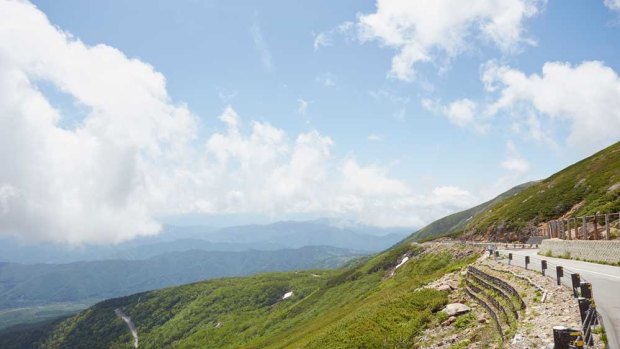By Roger Balch

After Mount Fuji and Mount Ontake, Mount Norikura is the third tallest volcano in Japan.
SPONSORED
Well-maintained roads, polite drivers, attendants to fill you up at service stations, zero horn honking… Japan is not only one of the most civilized driving nations, it offers some stellar road trips for the driving traveller.
HOKKAIDO
Where
Hokkaido is Japan's most northerly main island and its second-largest. Access to the island is by train via the 54-kilometre Seikan Tunnel, by plane to one of the many airports, of which New Chitose Airport just south of the capital Sapporo is the largest, or by ferry.
Why
Hokkaido is known for its beautiful nature, wild flowers, bird life, lakes and mountains. It's well-suited for driving because its small country roads are inaccessible by large tour coaches and the railway network of Hokkaido may not take you directly to every area of exploration.
Don't miss
The autumn foliage colours, especially in Furano, Biei, Niseko, Toya, and the cities of Sapporo and Otaru. The Furano and Biei areas are also famous for their rainbow flower fields, wide blue sky and cobalt blue pond. Local produce includes cheese and Yubari cantaloupe melons.
IROHA-ZAKA WINDING ROADS
Where
This pair of famous winding roads is in the mountains of Tochigi Prefecture on the main island of Honshu. They connect the lower elevations around central Nikko to the mountainous Okunikko region and ascend as high as 440 metres. Motorists go up on the Second Iroha-zaka and down on the First Iroha-zaka.
Why
The spectacular Iroha-zaka Winding Roads comprise 48 hairpin bends, each corresponding to a letter of the ancient Japanese alphabet. Each turn is labelled with its character and you'll pass them in alphabetical order.
Don't miss
Go slow to enjoy the breathtaking panoramic views and the adrenaline rush of navigating the many curves. Visit the Akechidaira Plateau near the top of the ascending Iroha-zaka road for breathtaking views of Kegon Falls, Lake Chuzenji and Mt Nantaisan. This picturesque spot offers views of flowers in spring, lush greenery in summer, vivid colours in autumn and snow in winter.
SHIKOKU ISLAND
Where
Shikoku is Japan's smallest and least populous major island, south of the largest main island of Honshu and east of the island of Kyushu.
Why
The island is a fun combination of excellent highways and steep, winding country roads which make it fun and exciting to explore. The enchanting Iya Valley in Tokushima Prefecture is one of Japan's Three Hidden Valleys, and offers dramatic mountain scenery, thatched-roofed Japanese-style houses and historic vine bridges (not suitable for vehicles!).
Don't miss
The enchanting small islands of Megijima and Ogijima are a short ferry ride from the city of Takamatsu in the Seto Inland Sea. Takamatsu has been referred to as the uncrowned capital of udon, so pop into a restaurant for a slurp of these firm, chewy noodles, either cold with a dipping sauce or in a hot broth with all the trimmings.
NORIKURA SKYLINE
Where
Mount Norikura is the third tallest volcano in Japan (after Mount Fuji and Mount Ontake) and on the southern edge of the Northern Japan Alps about 280 kilometres west of Tokyo. The Norikura Skyline is a road that tunnels through the mountain.
Why
Japan's highest road is an invigorating drive with panoramic views of the Northern Alps Mountain Range. Person vehicles are not allowed on the mountain, however there are several parking areas from where you can take a bus or taxi; the 3026-metre peak Kengamine can only be reached on foot.
Don't miss
Mount Norikura and hardened lava flows can be seen near the peak. The views of the Yarigatake and Hodaka mountain range are astounding. The last stop is Tatamidaira, where those keen to stretch their legs can view alpine plants, the Siberian dwarf pine and artful flocks of birds while looking over the crater lakes.
ESSENTIALS
Paperwork
You will need to obtain an International Driving Permit available from your local motoring organisation such as the NRMA, RACV or RACQ before you leave Australia.
Car rental companies
There are several Japanese car-rental companies, many of which have English websites and support, as well as the familiar international names. There are also independent reservation websites including Japan Experience and ToCoo! Travel.
Rates
Prices usually include unlimited mileage, taxes and a compulsory minimum insurance fee covering damage, injury and liability.
GPS
Most rental cars have a GPS navigation system built into the dashboard. Most rental companies offer English-capable systems, which should be reserved in advance. It's easiest to input your destination by its phone number.
Toll card
The ETC (electronic toll collection) card is inserted into a transceiver in your rental car that wirelessly connects with highway toll gates. You can rent one with your vehicle.
Roadside stops (Michi-no-eki)
Located along national highways, these rest areas provide free parking, restrooms and tourist information for drivers, along with souvenir stores, cafes and more.
Petrol
Self-service stations are becoming more popular but may have only Japanese-language instructions. Many petrol stations close at night.
See also: Must-have Japanese food you've never tried
See also: Hiking in Japan? Yes, you can
This article is brought to you by Japan National Tourism Organization.
Looking for a warm getaway during the Australian winter? Find the best travel ideas for summer in Japan, along with inspiration and travel tips at Japan National Tourism Organization's website, jnto.org.au
Sign up for the Traveller Deals newsletter
Get exclusive travel deals delivered straight to your inbox. Sign up now.